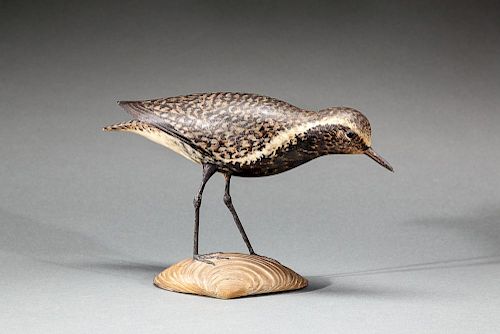Running Black-Bellied Plover
About Seller
20 Winter Street
Pembroke, MA 02359
United States
Founded in 2005, Copley Fine Art Auctions is a boutique auction house specializing in antique decoys and American, sporting, and wildlife paintings. Over the course of the last two decades, the firm has set auction records for not only individual decoy makers, but also entire carving regions. Copley...Read more
Two ways to bid:
- Leave a max absentee bid and the platform will bid on your behalf up to your maximum bid during the live auction.
- Bid live during the auction and your bids will be submitted real-time to the auctioneer.
Bid Increments
| Price | Bid Increment |
|---|---|
| $0 | $50 |
| $1,000 | $100 |
| $2,500 | $250 |
| $5,000 | $500 |
| $10,000 | $1,000 |
| $25,000 | $2,500 |
| $50,000 | $5,000 |
About Auction
Jul 25, 2015 - Jul 26, 2015
Copley Fine Art Auctions cinnie@copleyart.com
- Lot Description
A. Elmer Crowell (1862-1952), East Harwich, MA, c. 1912
This early plover carving with its elegant form and strong provenance is one of Crowell's finest decorative plover carvings known to exist. The paint detail is among the best known to have been executed on any plover by the maker.
In a bold running position, this carving measures a full eleven and one-half inches from the tip of the bill to the tail and shows the artisan's finest original paint, with terrific intricate feather detail and blending. The layered impasto paint technique that he imparted upon his early carvings created a lifelike effect on the birds which is virtually unmatched by any carver of his day or since. The vermiculation on this plover where the black belly meets the white sides is reminiscent of Crowell's famous preening pintail made for Crowell patron, author, and naturalist Dr. John C Phillips, Jr. (1876-1938). This plover along with the famous pintail both hail from the Russell B. Aitken Collection of Wildfowl Decoys. While it remains a mystery as to whom Crowell created this masterwork for, Dr. John C. Phillips, Jr. (1876-1938), Dr. John H. Cunningham, Jr. (1877-1960), and Charles Ashley Hardy (1874-1929) are all likely candidates.
The bill of the bird displays incised mandible separation as well as subtle nostril carving. With its black glass eyes, the bird likely pre-dates 1915. Crowell used black glass eyes before switching to brass tacks eyes on his bigger birds, most of which are found on his 1915-1924 carvings. The carving displays nice separation between the wingtips and extended tail. When Crowell initially began carving he was far more consumed with rendering a perfect likeness for each species. Typical of many artists, as his carvings gained in popularity and demand increased, his attention to detail began to wane. With this particular bird, Crowell went so far as to paint the auricular feathers below the eyes; this plover is believed to be one of the only such examples with this precise detail. A related curlew with similar auricular treatment was sold by our firm as the cover bird, lot 198, on the the Sporting Sale Catalog, July 26, 2007.
Displays Crowell's pristine oval brand on the bottom of the surf clam base. According to Crowell historian Gigi Hopkins the auricular treatment is quite rare and the crisp brand is one of the earlier strikes she has ever seen. The oval brand was purchased by Crowell in 1912.
Provenance: The Russell B. Aitken Collection
Private CollectionLiterature: Christie's, "The Russell B. Aitken Collection of Waterfowl Decoys," New York, NY, 2003, pp. 4 and 61, lot 1126, exact carving illustrated.
Stephen O'Brien, Jr. Fine Arts, LLC., "Select Carvings by A. Elmer Crowell (1862-1952)," Boston, MA, 2008, exact carving illustrated.Condition
Original paint with minimal restoration to thighs and feet.
- Shipping Info
-
Shipping info
Copley Fine Art Auctions does not handle the shipping of any items. Shipping is the sole responsibility of the buyer. Once your payment has cleared, and we have received your authorized shipping release form items may be released for shipment. Copley Fine Art Auctions, LLC shall have no liability for any loss or damage to such items. Buyers should allow up to four weeks for shipment.PLEASE BE AWARE THAT INTERNET BIDDERS MAY NOT PICK UP THEIR ITEMS AT THE SALE SITE. ITEMS CAN BE PICKED UP BY APPOINTMENT OR SHIPPED STARTING FIVE DAYS AFTER THE CONCLUSION OF THE SALE
-
- Buyer's Premium



 EUR
EUR CAD
CAD AUD
AUD GBP
GBP MXN
MXN HKD
HKD CNY
CNY MYR
MYR SEK
SEK SGD
SGD CHF
CHF THB
THB















